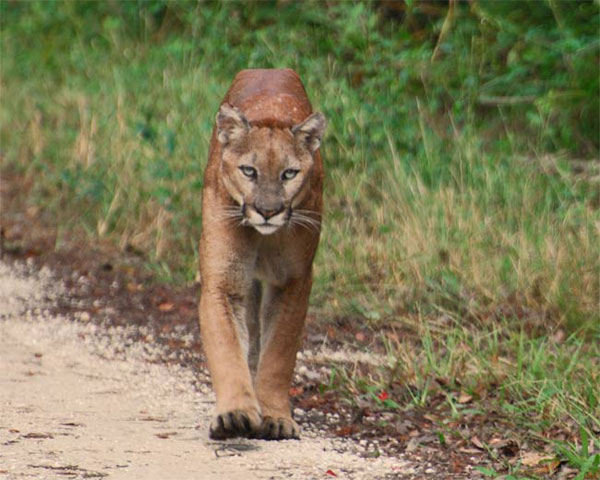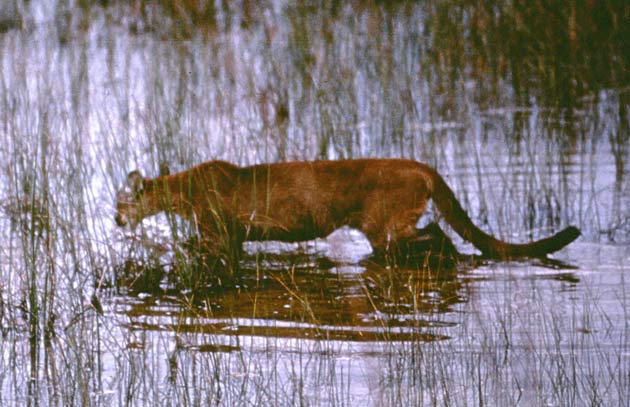Fading Florida Panthers Need New Paths to Safety


Michael Sainato is a freelancer with credits including the Miami Herald, Huffington Post and The Hill. Follow him on Twitter at @msainat1. Sainato contributed this article to Live Science's Expert Voices: Op-Ed & Insights.
A vanishing and elusive relic of nature, the cougar subspecies known as the Florida panther has been flirting with extinction in a dwindling wilderness for a century. With a habitat degraded to less than five percent of its historical range — veritable isolation in south Florida — wildlife conservationists estimate the panthers currently number between 100 and 200 individuals. With such a small population, experts believe the animal cannot maintain genetic diversity and survive.
For Florida panthers to expand their numbers, they need an expanded range, and as of this May, a corridor of protected lands are now linked, providing that needed space.
Exploring a wild corridor
The conservation land easement agreement — between the Nature Conservancy, the U.S. Department of Agriculture (USDA) Natural Resource Conservation Service (NRCS) and property owner Christopher Asplundh, billionaire and Chairman of the Pennsylvania-based Asplundh Tree Expert company — was finalized on 1,528 acres of the 1,800-acre Black Boar Ranch in LaBelle, Fl.
It is the last piece of land to be connected in a corridor for panthers that expands their territory north of the Caloosahatchee River. During a tour for journalists and project partners, I had an opportunity to see the new corridor, traveling in an open-air buggy as it traversed the foliage of the ranch, encountering herds of exotic elk, deer and antelope as they scrambled away from their shady resting spots.
A thin canal of tannic, turbid water slowly flows through Black Boar Ranch toward an underpass of State Road 80, where a portion of the conservation project — in collaboration with the Florida Department of Transportation — provides a means for panthers to travel north without the risk of being pummeled by a car on the road.
Get the world’s most fascinating discoveries delivered straight to your inbox.
The Florida Department of Transportation has constructed more than 70 wildlife underpasses on busy state roads throughout south Florida, each costing from $1 million to $2.5 million.
Once through the underpass, the animals must swim across the Caloosahatchee river, and researchers have only recorded a handful of full-grown male panthers doing so. A male panther's territory can exceed 200 square miles, and their current accessible habitat doesn't provide their population with nearly enough space to expand. A female panther hasn't been recorded north of the Caloosahatchee since 1973.
Due to the short distances females travel, in 2006, the U.S. Fish and Wildlife Service recommended transporting panthers to former habitats to facilitate their expansion. The report designated the Avon Park region as the best site for translocation, as it incorporated the largest amount of public land, providing the least fragmented suitable habitats for panthers to claim.
The new panther corridor is a mere blip in the report's recommendations, and the recommendations of many other scientists.
An expanded corridor
"The panther's current range isn't viable in the long term," said Michael Robinson, director of the Center for Biological Diversity, a non-profit organization of 625,000 members and activists around the world. "The 2008 Florida Panther Recovery Plan recommended three populations of at least 240 panthers," he added.
"The Okefenokee National Wildlife Refuge was determined to be the ideal place to create a second population of panthers based on studies," said Robinson. "But political considerations have blocked that. The plan detailed why it was also necessary to ensure panthers can cross the Caloosahatchee River to increase their distribution and numbers to mitigate genetic inbreeding. South Florida is seeing rampant, voracious development with significant negative impacts on biological diversity. Yet, by following the recovery plan, reintroducing panthers to the Okefenokee, and protecting remaining habitat and movement corridors, the Florida panther can still be saved."
The conservation easement at Black Boar Ranch was the last piece of property needed to create a corridor of protected lands from existing panther habitat to north of the Caloosahatchee River, but stricter and more expansive land conservation are needed.
The USDA Natural Resource Conservation Service provided 50 percent of the funds for the easement, as the property was classified as agriculture land.
"There is no restriction on the type or extent of farming, other than no sod farming, on the land easement," said USDA NRCS Agricultural Land Easements Coordinator, Nina Bhattacharyya. As agricultural development is still allowed on the land, the protection of natural habitat may potentially be jeopardized. [Texas Cats Give Florida Panthers Another 9 Lives]
Ecologists don't see the conservation of agricultural land and that of biodiversity as ideally compatible. "The greatest threat to biodiversity is habitat loss," said Nicholas Haddad of North Carolina State University. Haddad was the leading author of a twenty-year global study on habitat fragmentation and its impacts on biodiversity, which concluded that roads and other factors of habitat destruction and fragmentation lead to a significant downward trend in biodiversity over time.
"Agriculture often represents the destruction of forests or grasslands that can be very diverse, to cultivate one or a few species to feed people," Haddad added. "Thus, agriculture has massive effects on biodiversity . . . panthers are generalists that can survive where there is enough food. The problem is that once large carnivores wander from protected areas, they will rarely survive because people don't want them there" — All while any efforts to fund land purchases for conservation in Florida are in bureaucratic gridlock.
"In 2008, when the stock market crashed, the Florida Forever program that allocated $300 million annually — solely to the purchase and conservation of land in Florida — was depleted indefinitely," said Wendy Matthews, conservation project manager of the Nature Conservancy. "Since then, we haven't had funds for as many projects, so we had to be more creative and work with partners to focus on land protection and connecting key areas."
In 2014, Florida voters overwhelmingly passed Amendment 1 to the Land Acquisition Trust Fund created in 1963, revitalizing the funds lacking from the Florida Forever program. (The program was created for acquiring land for conservation and recreational purposes).
Amendment 1 mandated that the state spend a third of the revenue from already existing fees on real estate transactions, environmental preservation and conservation over the next twenty years (estimated by the coalition that ran the campaign for the amendment, Florida's Water & Land Legacy, to be in the billions of dollars.)
The funds are currently frozen in legislation as heated debates between citizens and lawmakers transpire over the money's intended uses — all while the Florida panther continues to receive insufficient protection and assistance in its survival.
Follow all of the Expert Voices issues and debates — and become part of the discussion — on Facebook, Twitter and Google+. The views expressed are those of the author and do not necessarily reflect the views of the publisher. This version of the article was originally published on Live Science.




